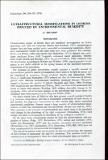Por favor, use este identificador para citar o enlazar a este item:
http://hdl.handle.net/10261/34333COMPARTIR / EXPORTAR:
 SHARE
BASE SHARE
BASE
|
|
| Visualizar otros formatos: MARC | Dublin Core | RDF | ORE | MODS | METS | DIDL | DATACITE | |

| Título: | Ultrastructural modifications in Lichens induced by environmental humidity |
Autor: | Ascaso, Carmen CSIC ORCID | Palabras clave: | Lichen Humidity Lichen |
Fecha de publicación: | 1978 | Editor: | British Lichen Society | Citación: | Lichenologist 10: 209-219 (1978) | Resumen: | Ultrastructural studies of lichens have not paralleled investigations on lichen physiology and, with one exception (Harris and Kershaw, 1971), morphological changes have not been studied under controlled environmental conditions. Moreover, contradictory results on the same topic have been published. For example, Brown and Wilson (1968) and Jacobs and Ahmadjian (1971a) claimed that under damp conditions lichen thalli frequently contained starch inclusions, whereas other results (Harris and Kershaw, 1971; Ascaso and Calvan, 1976) conflicted with this observation. According to Webber and Webber (1970), starch granules do not appear in wet thalli collected in the spring because of the increased metabolic requirement of the mycobiont. The pyrenoid of green phycobionts usually contains a variable amount of electron-dense particles named pyrenoglobuli; these seem to be lipid in nature and are considerad as secondary storage producís (Jacobs and Ahmadjian, 1969, 1971a, ¿>). Jacobs and Ahmadjian (1973) pointed out that the behaviour of pyrenoglobuli under different environmental conditions remained obscure. Dampness seemed to increase the number of globuli (Rudolph and Giesy, 1966; Peveling, 1969) except in one case (Brown and Wilson, 1968), and short-term desiccation was found to reduce their amount (Peveling, 1968) without detectable damage to the thylakoids. Other ultrastructural changes of the phycobiont that occur under dry conditions have been reported by Peveling and Galun (1976). The above reports have all failed to take into account several ecological factors (e.g. moisture, temperature) and thus a meaningful comparison of these results is not possible. In long-term experiments we have shown that, under controlled experimental conditions, dryness causes a large number of ultrastructural modifications in both the phycobiont and the mycobiont (Ascaso and Galván, 1976). The variations in the amounts of pyrenoglobuli and starch seem to be correlated with changes in the physiology of the algal component (Ahmadjian, 1974); such changes are likely to be induced by alterations in the ecological conditions. On the other hand, physiological studies on both the photosynthesis and respiration of lichens (Feige, 1972; Richardson, 1973; Larson and Kershaw, 1975; Kallio and Karenlampi, 1975) and the nutrient movement between symbionts (Richardson et al, 1967; Richardson, 1973; Armstrong, 1976; Hill, 1976) have not been complemented by ultrastructural investigations. The aim of the present work was to study, by electrón microscopy, the response of three lichens to moderately dry and wet conditions. The moisture levéis were selected so as to correspond to those for which physiological data are available. | Descripción: | 11 pages, figures, and tables statistics. | URI: | http://hdl.handle.net/10261/34333 | E-ISSN: | 0024-2829 |
| Aparece en las colecciones: | (IRN) Artículos |
Ficheros en este ítem:
| Fichero | Descripción | Tamaño | Formato | |
|---|---|---|---|---|
| lichenologit10111.pdf | 4,72 MB | Adobe PDF |  Visualizar/Abrir |
CORE Recommender
Page view(s)
368
checked on 07-may-2024
Download(s)
318
checked on 07-may-2024
Google ScholarTM
Check
NOTA: Los ítems de Digital.CSIC están protegidos por copyright, con todos los derechos reservados, a menos que se indique lo contrario.
